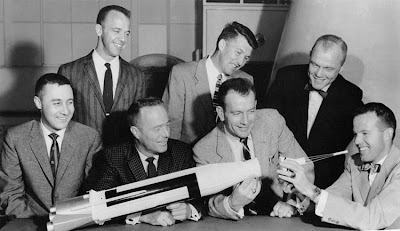I had the extraordinary pleasure of hearing legendary NASA flight director
Gene Kranz speak at the Bush Museum this week. He discussed his many years at NASA during the
Mercury,
Gemini and
Apollo programs, and told stories about some of the colorful personalities at Mission Control.
Astronaut
Fred Haise was introduced, then they took turns describing memories of the
Apollo 13 mission. If you saw the 1995 movie... Kranz was played by Ed Harris, and Haise was played by Bill Paxton. They spoke for about two hours, and I picked four clips to share -- intro, the explosion, moon photography and splashdown. Fred's entrance is below, and you can see others on
Pillownaut YouTube...
The videos make it look like they are just chatting in someone's living room! I didn't even need to use the zoom on my camera, because I was quietly recording snippets from the front row -- but there were hundreds of folks behind me, so my one regret here (well, aside from crappy editing) is not getting a shot of the actual auditorium and audience... because it was very well-attended and well-received by people of all ages.
They also mention astronaut
Joe Kerwin, who was about two millimeters away from me, LOL… but I didn't want to just stick my camera in his face, so I stayed focused on the stage. Kerwin was a Capsule Communicator (i.e. "CapCom") for Apollo 13, perhaps best known for asking the astronauts about their tax returns... and saying in hour 46:
"The spacecraft is in real good shape as far as we are concerned. We're bored to tears down here."Of course, a few hours later the explosion occurred, and that would be the last mention of boredom! Kerwin also flew on Skylab in 1973… he was both a scientist and pilot, as well as the first physician ever selected to be an astronaut.
When Kranz & Haise finished telling the story of
Apollo 13, they invited the audience to ask questions. Unsurprisingly, most people wanted to know what was true in the feature film, and what was phony. Snubbing the flight surgeon and navigating the craft by watching Earth in the window? Yeah, not so much. But most of the script, they insist, was true and very well-portrayed by the actors -- down to their triumphs, squabbles, and innovative solutions -- such as the square carbon dioxide filter being modified to fit a round receptor.
 Fred Haise, Jim Lovell & Jack Swigert in 1970
Fred Haise, Jim Lovell & Jack Swigert in 1970
Haise really set the audience cracking up when he recalled how Ron Howard asked him, "Why was it so problematic during the end? Was there really a danger of the parachutes not deploying? What were the technical reasons you almost skipped out of the atmosphere?"
Haise responded dryly,
"Oh, we did that so you could make a more dramatic movie."And I could seriously go on and on about their quips and stories! They were very funny and entertaining, but also very serious at times, when recalling their emotions during life-threatening situations. Listening to them, you'd think it happened just last week!
Formatting photos now, come back tomorrow to see part II...

















